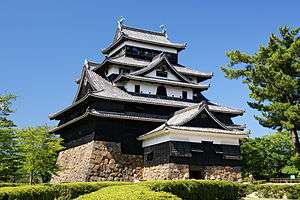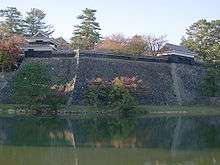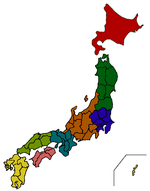Matsue Castle
Matsue Castle (松江城, Matsue-jō) is a feudal castle in Matsue in Shimane prefecture, Japan. Nicknamed the "black castle" or "plover castle", it is one of the few remaining medieval castles in Japan – at least of the few remaining in their original wooden form, and not a modern reconstruction in concrete.


The construction of Matsue Castle began in 1607 and finished in 1611, under the local lord Horio Yoshiharu. In 1638, the fief and castle passed to the Matsudaira clan, a junior branch of the ruling Tokugawa clan.
Most Japanese castles have been damaged or destroyed by war, earthquakes, or other causes. Since a large part of their construction was wooden, fire was a major hazard. Matsue castle was built after the last great war of feudal Japan, so it never saw a battle. Yet only some of the walls and the keep exist today.
Matsue Castle, standing on the shores of Shinji Lake, is one of Japan's Three Great Lake Castles. It is also known as a riverside district.[1]
History
Of the 100+ castles remaining in Japan, this is the only one remaining in the Sanin region. This castle is the second largest, the third tallest (30m) and the sixth oldest amongst castles. It was built over a period of 5 years by the daimyō of the Izumo region, Horio Yoshiharu, and was completed in 1611.
After the reigns of Horio Tadaharu and Kyōgoku Tadataka, Matsudaira Naomasa, a grandson of Tokugawa Ieyasu, became Lord of the castle, after being transferred from Matsumoto in Shinshu province, and thus began a reign that lasted 10 generations of the Matsudaira clan over a period of 234 years.
In 1875, all of the buildings within the castle were dismantled, with the exception of the castle tower itself, which was allowed to remain due to pressure from interest groups. The castle underwent a complete reconstruction between 1950 and 1955.
The castle is a complex structure, built in a watchtower-style, that appears to be five stories from the outside, but has, in fact, six levels inside. Most of the walls of the castle are painted black. It is a strong structure, built to withstand warfare, yet at the same time, it is majestic and solemn, reminiscent of the Momoyama style.
The castle has been registered as a national treasure of Japan on July 9, 2015.[2]
Literature
- Benesch, Oleg and Ran Zwigenberg (2019). Japan's Castles: Citadels of Modernity in War and Peace. Cambridge: Cambridge University Press. p. 374. ISBN 9781108481946.
- Schmorleitz, Morton S. (1974). Castles in Japan. Tokyo: Charles E. Tuttle Co. ISBN 0-8048-1102-4.
- Motoo, Hinago (1986). Japanese Castles. Tokyo: Kodansha. p. 200 pages. ISBN 0-87011-766-1.
- Mitchelhill, Jennifer (2013). Castles of the Samurai:Power & Beauty. USA: Kodansha. ISBN 978-1568365121.
External links
![]()
References
- "About Matsue Castle - Shimane Travel Guide | Planetyze". Planetyze. Retrieved 2018-02-13.
- http://tabijikan.com/article/17201/ | Matsue Castle - finally designed as a Japan's national treasure in 2015 | Retrieved 17 Jan 2017.
